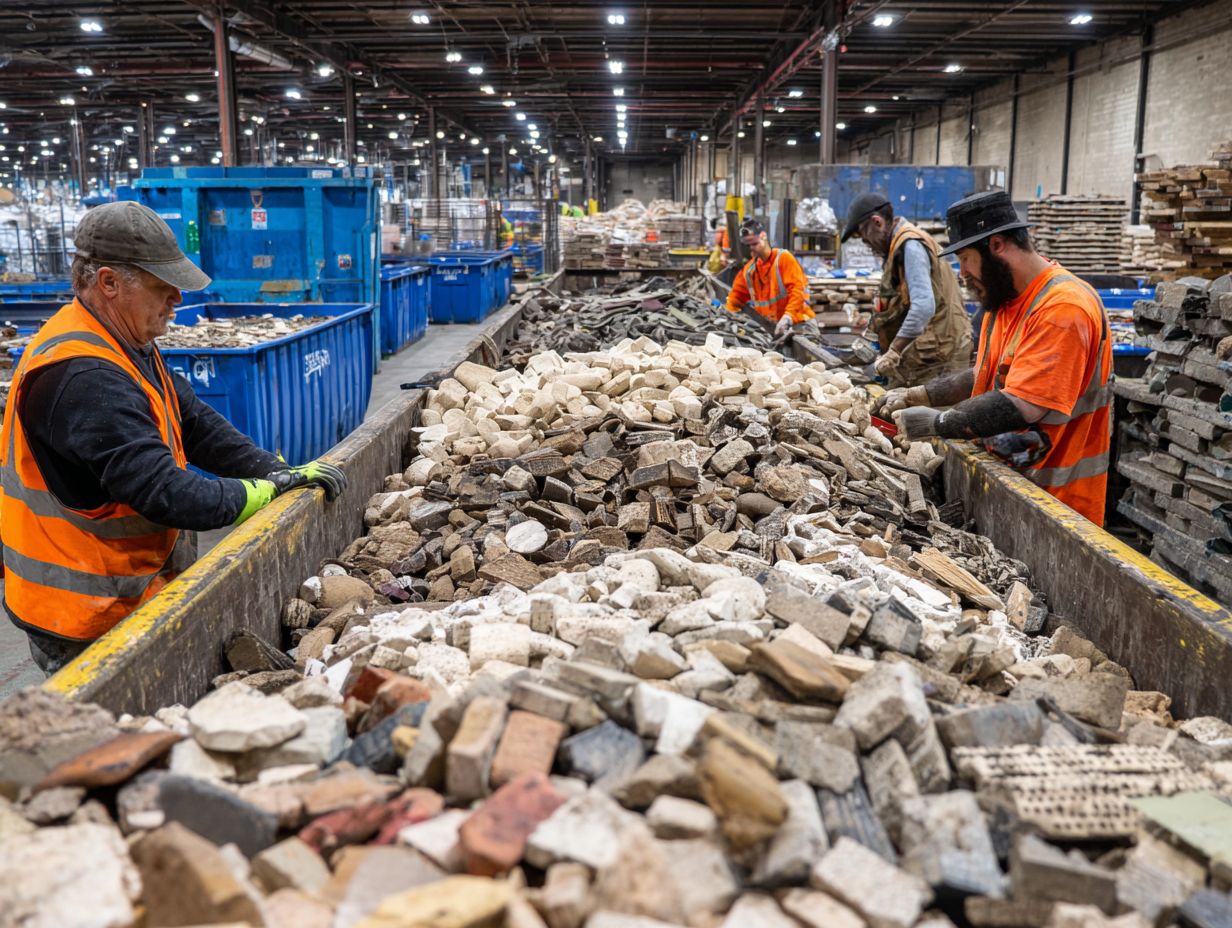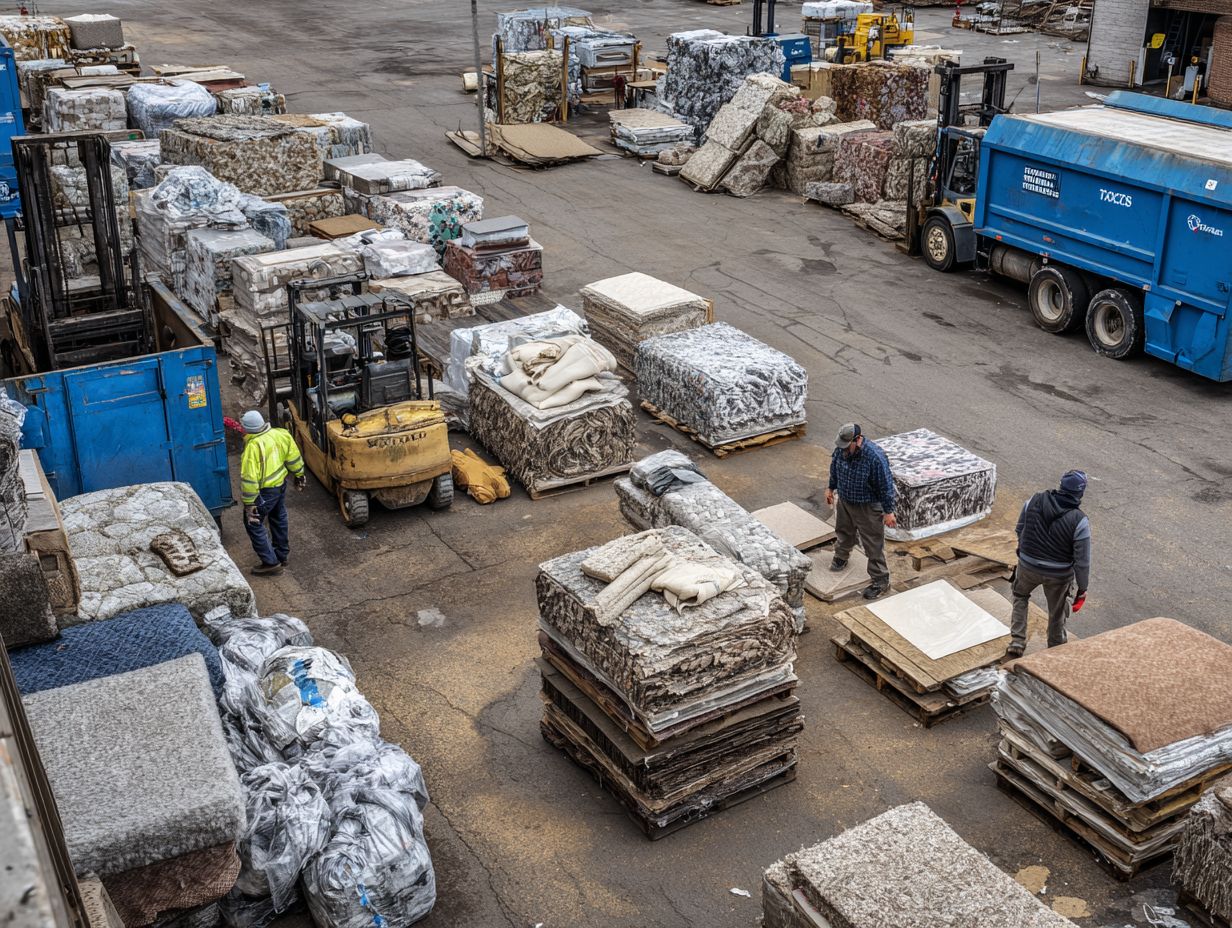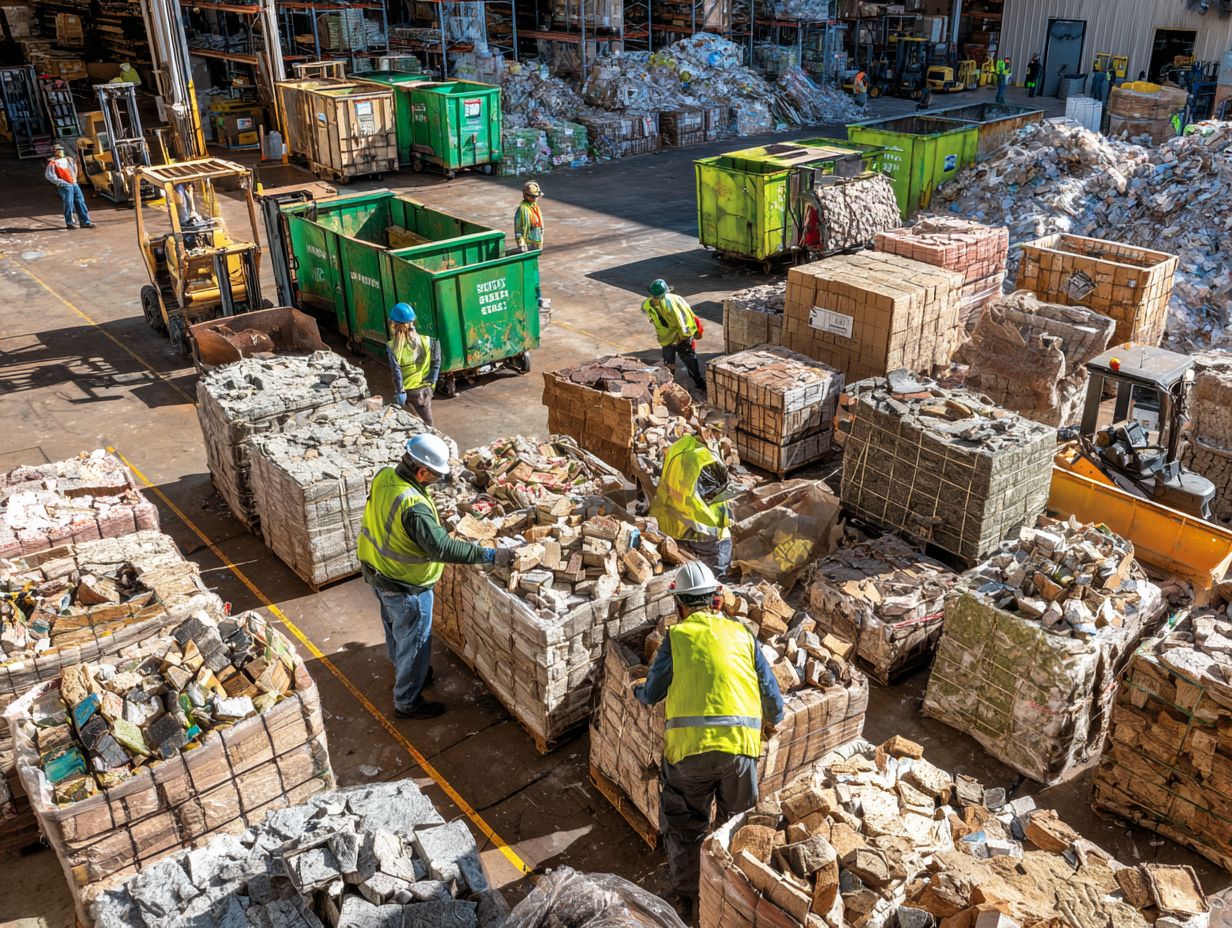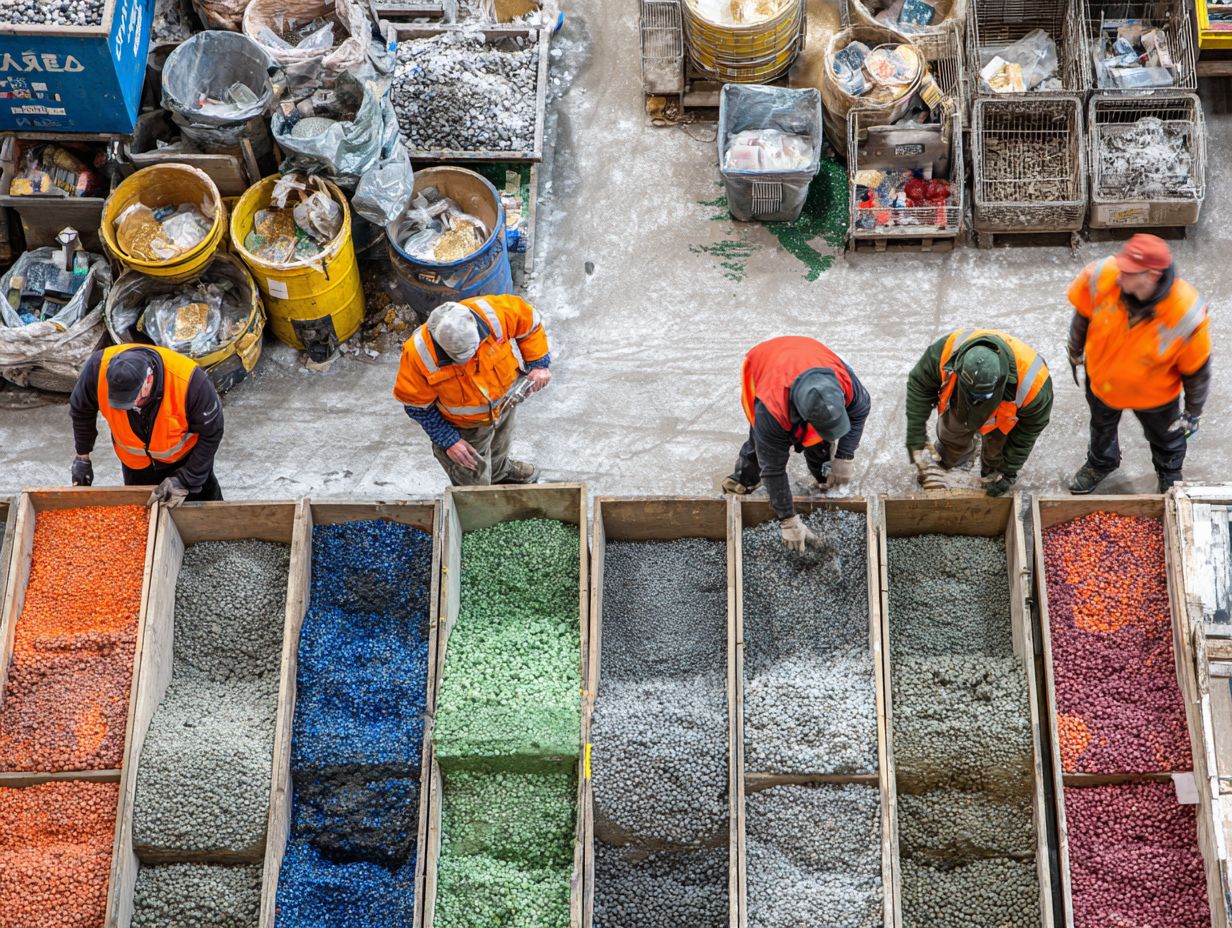Flooring End-of-Life – Disposal and Recycling
When it’s time for old flooring disposal, many homeowners face the challenge of managing materials like vinyl, laminate, and linoleum flooring responsibly. With different recycling methods available, knowing how to correctly dispose of these materials helps both the environment and community health. This article explains how to properly get rid of flooring and new ways to recycle, making sure your choices are good for the environment.
Key Takeaways:
Contents
- Disposal Methods
- Recycling Options
- Flooring Disposal & Recycling Statistics
- Flooring Disposal & Recycling Statistics
- Steps for Proper Disposal and Recycling
- Environmental Impact
- Regulations and Guidelines
- Innovations in Flooring Disposal and Recycling
- Frequently Asked Questions
- What is flooring end-of-life?
- Why is it important to properly dispose of flooring at its end-of-life?
- Is flooring recyclable at its end-of-life?
- What are some options for disposing of flooring at its end-of-life?
- Can flooring be reused or repurposed at its end-of-life?
- How can I make sure flooring is thrown away correctly when it’s no longer usable?
Importance of Responsible Disposal

Responsible disposal of flooring materials minimizes environmental impact and supports local recycling initiatives, essential for sustainable living.
Improperly disposed flooring contributes to landfill overflow, releasing harmful pollutants into the environment.
To counter this, consider donating usable materials to local charities like Habitat for Humanity, which repurposes them for housing projects. You can research local recycling centers that specifically accept flooring materials for proper disposal.
By choosing programs from flooring companies that focus on reuse and recycling, you cut down on waste and help promote environmentally friendly habits in your area.
Overview of Flooring Types
Common flooring types such as vinyl, laminate, and linoleum vary significantly in their disposal and recycling options, affecting both cost and environmental footprint.
Vinyl flooring, often made from PVC, can be challenging to recycle due to its composite materials. Some manufacturers offer programs to take back old flooring.
Laminate, composed of melamine resin and fiberboard, is usually not recyclable but can often be repurposed. Linoleum, made from natural materials like linseed oil, is biodegradable and can be composted at its end-of-life.
When thinking about flooring installation, ask your supplier about disposal options to make an eco-friendly decision. This aligns with the principles outlined in our analysis of carbon footprint considerations of flooring materials – Eco Analysis.
Disposal Methods
Different ways to dispose of flooring materials exist, and they each affect the environment and incur costs differently. Worth exploring: Local vs Imported Flooring – Environmental Impact for insights on how different choices can further impact environmental sustainability.
Landfill Disposal
Landfilling flooring waste is often the easiest option, but it presents long-term environmental concerns, particularly with non-biodegradable materials like vinyl.
In 2023, the volume of flooring waste reaching landfills is estimated to be over 3 million tons annually, a staggering figure that contributes to soil and water contamination.
To mitigate this, consider using reclamation services that can recycle flooring materials like wood, carpet, or tile. Tools such as the Conservatree Paper Calculator can help assess the environmental impact of discarded materials.
Familiarize yourself with local regulations on waste disposal, as some regions impose strict limits on non-recyclable materials in landfills. Using improved disposal methods helps solve environmental issues and supports sustainability in the industry.
Incineration
Incineration can provide a method for flooring disposal that recovers energy, but it raises concerns about emissions and the types of materials being burned.
The incineration process converts flooring materials like vinyl or composite into energy through combustion, but it’s essential to know which materials are acceptable.
Consider regulations that limit harmful emissions, such as the Clean Air Act in the U.S., which mandates specific filters to reduce pollutants.
The benefits are reduced waste in landfills and generating energy, but the downsides include the potential release of harmful chemicals if incorrect materials are burned.
To mitigate these risks, always consult local environmental regulations and work with certified waste management firms.
Composting
Composting is a viable method for disposal of certain flooring materials, particularly those made from natural fibers, but not all flooring is suitable for this method.
Materials like jute, coir, and wool can be composted effectively. Programs in places like Seattle and San Francisco have successfully integrated composting systems for natural fiber products, encouraging sustainable waste management.
Residents can drop off these materials at designated composting sites or participate in curbside pickup. Avoid composites or synthetic materials, as they take too long to break down and can contaminate compost piles.
Focus on using flooring options that highlight sustainability, enhancing both environmental benefits and community involvement.
Recycling Options
Recycling flooring materials offers many choices that can greatly cut down on waste and support sustainability efforts.
Types of Recyclable Flooring Materials
Key recyclable flooring materials include laminate, PVC, and linoleum, each needing different recycling processes to recover useful resources.
Laminate flooring can often be recycled through specific drop-off centers that grind it down for use in new products. PVC, on the other hand, can be sent to specialized recycling facilities where it’s melted and remolded, usually requiring disassembly to separate it from adhesives.
Linoleum is compostable and can also be recycled; many regions have programs that handle its reprocessing into new linoleum or other materials.
To find facilities, check local waste management websites or use apps like iRecycle, which provide nearby recycling options.
Benefits of Recycling Flooring
Recycling flooring saves materials and cuts down on trash, offering benefits for the economy and the environment.
By opting for reclaimed wood or recycled vinyl, you can significantly lower project costs while promoting sustainability.
For example, using reclaimed hardwood flooring adds a unique look to interiors and can be up to 50% cheaper than new materials.
Organizations like the U.S. Green Building Council recognize recycled materials in LEED certifications, enhancing your project’s sustainability profile.
Working with local recycling centers can provide special materials, support a system where resources are reused, reduce harm to the environment, and help achieve design objectives.
Flooring Disposal & Recycling Statistics

Flooring Disposal & Recycling Statistics
Disposal and Recycling Rates: Carpet Disposal
Disposal and Recycling Rates: Durable Goods Management
Disposal and Recycling Rates: Environmental Impact of Recycled Carpet
Disposal and Recycling Rates: California Carpet Recycling Progress
The Flooring Disposal & Recycling Statistics Give a detailed overview of the present situation regarding carpet and durable goods disposal, the rates at which they are recycled, and how recycling efforts affect the environment. The data highlights critical areas where improvements can significantly reduce environmental burdens.
Carpet Disposal statistics indicate that 91% of carpets are landfilled annually, with only 5% being recycled. This highlights a significant environmental challenge, as most carpets contribute to landfill waste rather than being processed for reuse, which could conserve resources and reduce landfill space usage.
Durable Goods Management shows a somewhat improved outlook, with 57.1 million tons of durable goods generated in municipal solid waste (MSW). Of these, 18.5% are recycled, 26.4% are combusted with energy recovery, and 25.6% are landfilled. These figures suggest that while some progress is made through recycling and energy recovery, a large portion still ends up in landfills, indicating room for improvement in waste management strategies.
Focusing on the Environmental Impact of Recycled Carpet, recycling processes for materials like nylon significantly reduce the carbon footprint. There is a 90% reduction in global warming impact when nylon from carpets is recycled. Additionally, the production of ECONYL, a recycled nylon, saves approximately 70,000 barrels of crude oil and avoids 65,100 tons of carbon emissions per 10,000 tons produced. These statistics clearly show the significant environmental advantages of recycling carpets.
Efforts in California Carpet Recycling Progress show positive trends, with a 107% increase in recycling rate over five years. This progress reflects the success of initiatives aimed at improving recycling infrastructure and public awareness. Since the program’s inception, 1 billion pounds of carpet have been collected, demonstrating the impact of state-level policies in driving environmental sustainability.
In summary, while the statistics reveal significant challenges in carpet and durable goods disposal, they also highlight the potential environmental benefits of recycling. Efforts to raise recycling rates and create effective recycling methods are important for lessening reliance on landfills and lowering harm to the environment. The data illustrates the need for broader adoption of recycling programs and policies that support sustainable practices across the flooring industry.
Steps for Proper Disposal and Recycling
Using a clear process for getting rid of and recycling flooring makes sure the materials are dealt with in a responsible and effective way.
Assessment of Flooring Materials
Correctly identifying flooring materials is essential for deciding how they can be disposed of or recycled.
- Start by identifying the type of flooring you have-common materials include hardwood, vinyl, carpet, and tile. Each has different recycling pathways.
- For example, check if your vinyl flooring includes a recycling symbol; some manufacturers will take it back.
- For carpet, look for labels indicating it’s made from recycled materials, as these are often eligible for recycling programs.
Don’t mix different materials; sorting them wrong can cause pollution and stop recycling from working well, reducing the positive effects on the environment.
Finding Local Recycling Facilities
Identifying local recycling facilities is essential for ensuring that flooring materials are disposed of in an environmentally friendly manner.
To find recycling facilities in your area, start with online resources like Earth911.com, where you can enter your zip code to locate nearby recycling centers.
Check your local government’s waste management website, which often lists designated recycling drop-off locations and scheduled collection events. Programs like FreeCycle also yield options for donating reusable materials.
Joining local groups on platforms like Facebook can give you suggestions and help share resources for recycling flooring materials effectively.
Preparing Flooring for Recycling

Getting flooring materials ready in the right way helps meet recycling rules and increases the likelihood of them being recycled successfully.
Start by thoroughly cleaning the flooring to remove dirt, adhesives, and contaminants. Use a steam cleaner or a high-pressure washer for stubborn residues.
Next, separate materials like wood, tile, and carpeting, as each has distinct recycling processes. Label each material clearly to avoid confusion.
Avoid combining different materials in one bin, which can lead to contamination.
Consider using local recycling apps or websites to find nearby facilities that accept your specific flooring types, ensuring they’re processed correctly.
Environmental Impact
The way flooring is thrown away affects air pollution, landfill usage, and carbon output in different ways.
Carbon Footprint of Flooring Disposal
The carbon footprint associated with flooring disposal can be substantial, particularly with materials like PVC which release harmful emissions when incinerated.
For example, the incineration of PVC flooring can emit up to 2.4 tons of CO2 per ton of material, significantly contributing to greenhouse gas emissions. In contrast, recycling processes can reduce this footprint dramatically.
Recycling materials such as wood and laminate reduces waste going to landfills and decreases emissions by 60% compared to burning.
Utilizing services like the Carpet America Recovery Effort, which promotes recycling of used carpeting, can help homeowners and contractors make environmentally-friendly choices, turning old flooring into new products instead of waste.
Impact on Landfills
Improper flooring disposal significantly contributes to landfill overcrowding, exacerbating environmental challenges and increasing operational costs.
In fact, flooring waste accounts for approximately 10% of total construction debris, with millions of tons ending up in landfills each year.
Recycling options are available, such as reclaiming hardwood floors or recycling carpet materials, which can reduce landfill contributions by nearly 60%. Working with certified recycling companies leads to responsible waste disposal and can save money on landfill fees.
By selecting eco-friendly flooring materials and using recycling methods, businesses can help reduce waste and support a more environmentally friendly world.
Regulations and Guidelines
Following the rules for flooring disposal is important to meet local and national legal requirements.
Local and National Regulations
Local and national regulations dictate specific guidelines for flooring disposal, varying widely based on material types and disposal methods.
For instance, the EPA mandates that vinyl flooring be disposed of in a landfill that meets certain criteria, whereas carpet may require recycling at designated centers due to harmful components like adhesives.
Noncompliance can lead to substantial fines-ranging from hundreds to thousands of dollars-depending on jurisdiction.
To follow the rules, companies should often check local waste management rules and use websites like RecycleNation or Earth911 to find proper disposal methods.
Keeping detailed records of disposal methods can help reduce compliance problems.
Best Practices for Compliance
Following standard procedures for compliance guarantees that flooring disposal aligns with all government rules and supports environmental health.
To follow the rules, start by writing down each step of taking out and throwing away the flooring, such as the kinds of materials and the quantities involved.
Schedule regular reporting to relevant authorities, providing updates on disposal processes. It’s essential to partner with certified disposal services that adhere to local regulations, ensuring responsible handling of waste.
Create a compliance checklist for each project, covering communication with contractors, verifying their certifications, and keeping records of disposal receipts.
Following these practices meets legal requirements and helps make flooring disposal more environmentally friendly.
Innovations in Flooring Disposal and Recycling
New ways to handle and recycle flooring are being developed, providing better solutions and tools that improve how we work and care for the environment.
New Technologies in Recycling
Recent advancements in recycling technologies, such as eco-friendly shredding methods, are revolutionizing how flooring materials are processed.
A significant development is the use of cryogenic grinding by companies like Reclaimed Wood Exchange. This method uses liquid nitrogen to freeze materials, which makes them simpler to break into smaller pieces.
Companies like Mohawk Industries are putting money into machine sorting systems that make it easier to separate different flooring materials, which increases recovery rates.
These methods improve recycling and cut waste, showing how the flooring industry is using better techniques to become more sustainable.
Case Studies of Successful Programs

Some successful programs show that new ways to recycle flooring work well, and they are establishing rules for upcoming projects.
One notable case is the Carpet America Recovery Effort (CARE), which has successfully increased carpet recycling rates from 2% to over 20% since its inception. They do this by building strong connections and organizing collection activities.
Interface, a global flooring manufacturer, has implemented a take-back program that turns old carpet tiles into new products, reducing waste significantly.
These examples demonstrate that collaboration with local governments and businesses is essential for creating effective drop-off points and educational programs, resulting in new recycling approaches going forward.
Handling Flooring Disposal in Coming Years
New trends in handling the disposal of flooring materials are focusing on environmentally friendly methods and recycling strategies.
One significant shift is the use of recycled materials in flooring products. Companies like Interface have pioneered modular carpet tiles made from 100% recycled content, reducing waste significantly.
Increasing consumer demand for sustainable options is pushing brands to adopt transparent supply chains, allowing customers to trace materials back to their origins. Innovations such as biodegradable flooring alternatives and take-back programs encourage recycling post-use, enhancing the transition to a circular economy.
These methods reduce harm to the environment and connect with more people who care about being eco-friendly.
Frequently Asked Questions
What is flooring end-of-life?
Flooring end-of-life is when a flooring material is no longer usable and must be thrown away or recycled. This can happen due to wear and tear, damage, or simply needing to update the look of a space.
Why is it important to properly dispose of flooring at its end-of-life?
Proper disposal of flooring at its end-of-life is important for both environmental and health reasons. Improper disposal can release harmful chemicals into the environment and impact the health of individuals. It also helps to reduce waste and promote sustainable practices.
Is flooring recyclable at its end-of-life?
Some types of flooring are recyclable at their end-of-life, such as carpet, vinyl, and laminate. Check with your local recycling center to find out if they take these materials and how to prepare them for recycling.
What are some options for disposing of flooring at its end-of-life?
In addition to recycling, there are other options for disposing of flooring at its end-of-life. This includes repurposing the material for other projects, donating it to a charity or organization, or disposing of it at a designated waste management facility.
Can flooring be reused or repurposed at its end-of-life?
Depending on the type of flooring, it may be possible to reuse or repurpose it at its end-of-life. This can save it from ending up in a landfill and give it a new life in a different space. Check with local organizations or online communities for ideas and resources on repurposing flooring.
How can I make sure flooring is thrown away correctly when it’s no longer usable?
To get rid of flooring when it reaches the end of its use, look into local recycling centers and waste services. Also, check with manufacturers or stores to see if they offer take-back or recycling options. Follow guidelines for preparing the material for disposal and consider environmentally-friendly options for replacement flooring.



